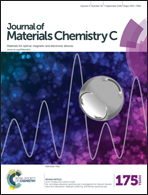Utilizing 9,10-dihydroacridine and pyrazine-containing donor–acceptor host materials for highly efficient red phosphorescent organic light-emitting diodes†
Abstract
Two novel materials, 10-(6-(dibenzo[b,d]furan-1-yl)pyrazin-2-yl)-9,9-diphenyl-9,10-dihydroacridine (PrFPhAc) and 10-(6-(dibenzo[b,d]thiophen-1-yl)pyrazin-2-yl)-9,9-diphenyl-9,10-dihydroacridine (PrTPhAc), were designed and synthesized by introducing heterocyclic pyrazine between 9,10-dihydroacridine and dibenzofuran/dibenzothiophene moieties. The basic properties, such as thermal, photophysical and electrochemical properties, were systematically investigated and compared. Both the materials have suitable triplet energies for red phosphorescent organic light-emitting diodes, and dibenzofuran (DBF) derivative PrFPhAc was finally achieved with superior external quantum efficiency of 22%.


 Please wait while we load your content...
Please wait while we load your content...